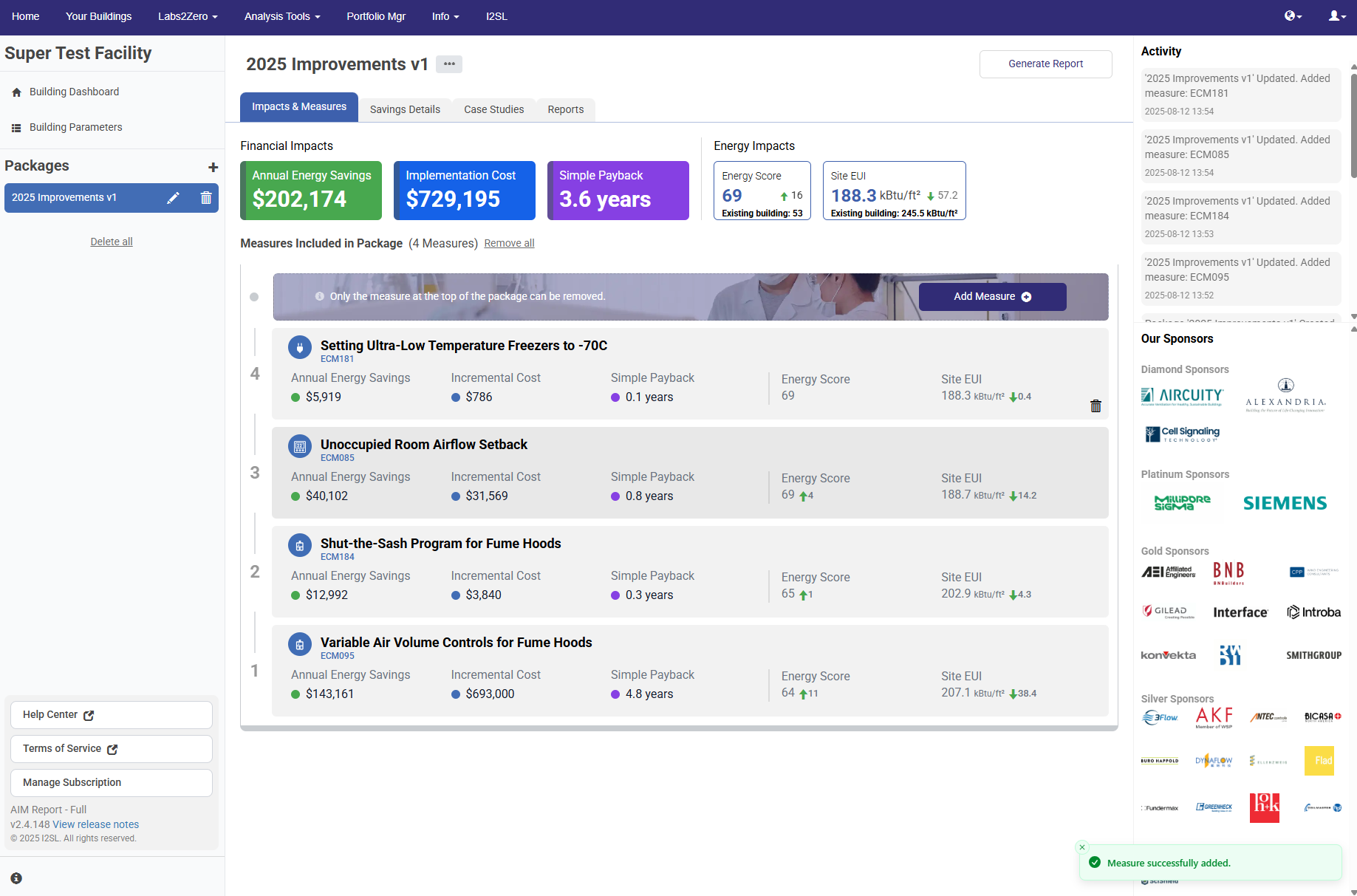I2SL Helps Identify and Prioritize Energy-Saving Opportunities in Lab Buildings
To help lab owners, designers, and engineers ensure energy efficiency and enhance decarbonization efforts, the International Institute for Sustainable Laboratories (I2SL) recently launched a new software tool, the Actionable Insights and Measures (AIM) Report, to provide automated energy audits for lab buildings. The tool allows owners and designers to rapidly identify energy-saving opportunities for their facilities and provides quantitative estimates of savings and implementation costs. This article introduces the AIM Report and describes how it works and how it can be used to build the business case for energy efficiency in labs.
Why focus on lab energy improvement?
Lab buildings, high consumers of energy with stringent design requirements and many key stakeholders, have long been underserved by programs seeking to reduce the energy use and emissions of buildings. I2SL’s Labs2Zero program aims to address these unmet needs, by providing tools both to evaluate the performance of lab facilities and to identify opportunities to improve it. The two Labs2Zero building performance scores, the Energy Score and Operational Emissions Score, are available at no charge on I2SL’s Laboratory Benchmarking Tool (LBT) website. The newest program offering, the AIM Report software, goes beyond assessment to offer customized, quantitative insights into performance improvement opportunities for lab facilities.
Alison will discuss the AIM Report, as well as how to identify cost-effective energy-saving opportunities and develop actionable strategies for labs, at the 2026 Lab Design Conference, taking place in Orlando, FL on May 11-14. Don’t miss her session on “Energy Improvement When Challenged with Shrinking Budgets.” Register now to secure your spot!
Given limited information about a facility and its energy usage, the AIM Report identifies potential savings opportunities and provides screening-level estimates of their energy cost savings and implementation costs, customized to that facility. It also displays information on the next steps to develop these potential projects and offers relevant case studies showing the selected opportunities in action in similar facilities. The new software is integrated with the existing LBT platform, meaning that benchmarking and measure identification can occur in quick succession. Within the AIM tool, the user builds “packages” of measures from a list of applicable options and the results can be exported as a PDF report to share with others.
Aiming for better performance
The AIM Report guides architects, engineers, facilities staff, and planners in identifying and prioritizing energy-saving projects across diverse lab types, helping build the business case for efficiency and investment. Image: Courtesy of I2SL
The AIM Report was designed to be used by a wide range of lab industry professionals to help build the business case for energy projects in lab facilities. Architects and engineers can input existing building data to zero in on energy-saving renovation projects for further development, or model design parameters to identify efficiency features to include in planned projects. Facilities staff can use the AIM Report as an initial screening tool to prioritize lab building, system, and equipment improvement projects, while planners can use it to audit multiple research buildings to help determine portfolio-wide investment priorities. In addition, utility companies’ energy efficiency programs may use the AIM Report to identify potential projects for customer incentives. In all cases, use of the tool should be followed by detailed project development and design in advance of implementation.
The tool is compatible with many types of lab building, including basic R&D research, product development, and teaching labs, in academic, commercial, and government settings. AIM includes measures and calculations applicable to chemistry, biology, physical sciences, and engineering lab facilities. However, the AIM software does not yet accommodate some specialty lab types, such as manufacturing facilities, vivarium facilities, biosafety level (BSL) 3 or higher labs, and cleanrooms.
Expertise informed inputs
In developing the AIM Report, I2SL was guided by several important goals. These included creating a tool that is quick and easy to use and that provides objective results. To ensure that AIM was free from individual vendor bias, I2SL assembled a set of Technical Advisory Councils (TACs), composed of subject matter experts from across the laboratory lab owner, operator, engineering, building, and design communities. TAC volunteers helped I2SL make decisions about the AIM Report measures and their impacts on energy use, and about building model assumptions, costs to implement the measures, and case studies relevant to the measures included in the tool. Additionally, nearly 20 volunteers from the I2SL community piloted the AIM Report to test its usability and applicability prior to release, many using actual building data.
Development of the AIM Report was overseen by the I2SL Labs2Zero Leadership Council, which includes lab building owners, designers, builders, engineers, service providers, and health and safety professionals.
Calculating lab-specific factors
The AIM Report uses a lab-specific web calculator with intelligent assumptions and a library of energy-efficiency measures to provide tailored savings and cost estimates for each building. Image: Courtesy of I2SL
To perform its energy savings calculations, the AIM Report uses its own web-based calculator that was designed specifically to be used for lab buildings. The calculator focuses on the factors driving airflow rates in a building's lab spaces, including ventilation requirements, fume hoods, and equipment loads, and performs whole-building energy use calculations for a wide range of building design and operational parameters.
For each building, AIM uses a series of intelligent assumptions to assign values to any building parameters not provided by the tool user. The use of intelligent assumptions is a critical aspect of the AIM process, allowing users to quickly obtain meaningful results without the need to enter hundreds of pieces of data on each building. Users with time or additional information can override many of the assumptions to tweak the model to better reflect the conditions of their own building and improve the accuracy of the savings calculations.
AIM is equipped with a library of energy-efficiency measures, including many of the most important for lab facilities. The measures cover HVAC systems at building- and room-level, as well as fume hood upgrades and occupant engagement initiatives. AIM's measure implementation cost estimates are calculated for each measure based on the specific properties of each building. The cost estimates contain components corresponding to materials, labor, project management, staff time, and maintenance costs. The costs are also adjusted based on building location, using typical regional cost factors. All measure costs and savings estimates are presented incrementally within a package of measures, so savings and costs are never double-counted.
Case studies are drawn from a library assembled by I2SL, and each study is assigned a match score reflecting the quality of information available and the similarity of the project to the building and package selected by the user.
What’s next?
In the coming months, more features will be added to the AIM Report tool. These include a fully internationalized version; while the LBT is fully internationalized, the first version of AIM covers only U.S. facilities. Upcoming enhancements also include additional energy efficiency measures and new calculation features. Further ahead, I2SL plans to create a version of AIM that is dedicated to new construction facilities, an aspect of the Labs2Zero program known as Design2Zero. The LBT and AIM Report will also be integral to the upcoming International Fume Hood Challenge program from I2SL.
Join Alison in Orlando at the 2026 Lab Design Conference to explore the AIM Report and learn how to uncover cost-effective energy-saving opportunities for your lab. Don’t miss her session, “Energy Improvement When Challenged with Shrinking Budgets,” along with other sessions on sustainable lab design, stakeholder collaboration, lab renovations, and more. Register now to secure your spot!
Test drive the AIM Report
The AIM Report is hosted on I2SL’s lab benchmarking website at lbt.i2sl.org. While the full AIM Report software is a subscription service, the site includes a free demo version that allows access to the AIM software with a limited set of measures, but all the functionality of the full report tool.
Users with buildings already entered in the LBT can run the AIM Report on their buildings immediately. All others should begin by creating a free LBT user account and entering at least the minimum required data for a building. Quick Start Guides on LBT and AIM are available to give users tips on what data to gather and how to use the tools.
I2SL welcomes all feedback on the AIM Report and its other Labs2Zero tools. For feedback, questions, or to volunteer to serve on a Labs2Zero TAC, please contact labs2zero@i2sl.org.



